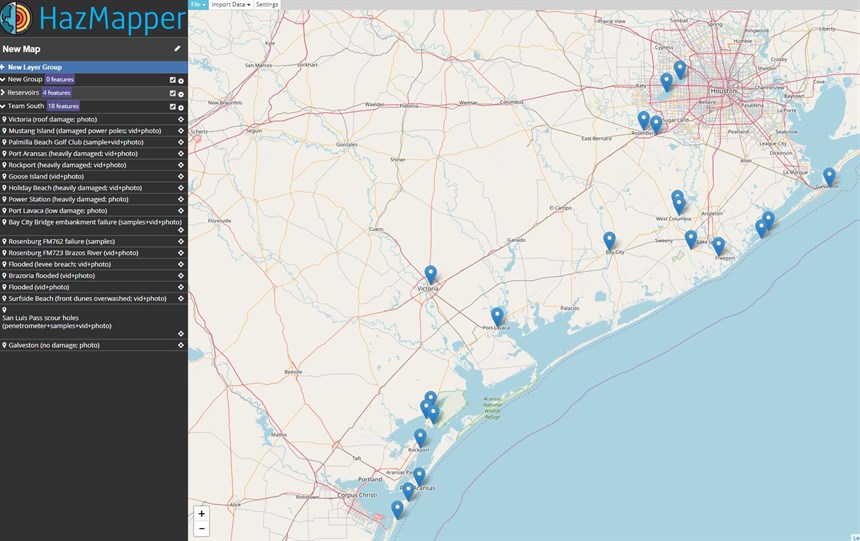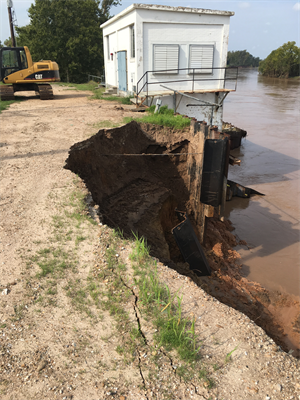Few students expect to be called upon to take action after a catastrophic event, and even fewer answer that call. After Hurricane Harvey struck the Texas coast on Aug. 25, causing wind and water damage along the coast and the Houston area, a group of civil engineers worked to study and collect data about the geotechnical aspects of coastal impacts during the hurricane in an effort to prevent structural damage in the wake of a future storm.
A week after the devastation, Iman Shafii, a Ph.D. candidate in the Zachry Department of Civil Engineering at Texas A&M University, joined other civil engineers as part of an investigation team to assess the erosion impact on the coast. By collecting data, results from the erosion studies can be used by local, state and federal organizations to aid in preparation for future weather disasters.
“We can research how a structure’s foundation failed and how to improve it for next time,” said Shafii. “Before the next disaster, we can get information from the soil and the areas around bridges and levees that failed. In order to prevent a failure, you have to modify the structure; if you’re going to have the same structure in the next hurricane, you’re going to have the same problem.”
Shafii, who has a concentration in geotechnical engineering, said the National Science Foundation (NSF) funds different groups to conduct engineering investigations after major disasters, including the Geotechnical Extreme Events Reconnaissance (GEER) team, which Shafii joined. Once all the information is recorded, the NSF shares it in a public archive for future use.
“The whole purpose behind this GEER team is to learn from the disaster and use that information for the next one,” Shafii said. “The goal was to go to those areas that are more prone to failure because of the hurricane, like the bridges and levees. We tried to cover a good amount of locations.”

The team traveled to southeast Texas, starting in the Corpus Christi area, and went along the coast for four days investigating soil quality and places where structures had failed at 14 different sites. They documented the hydraulic and geotechnical aspects of coastal impacts from Hurricane Harvey.
While on site, team members tested various components of the soil property including compression strength, undrained shear strength, moisture content, and soil erosion resistance. Shafii also collected more than 10 soil samples and is running erosion function apparatus tests on them at the Texas A&M Erosion Laboratory, where he works as manager.
 Shafii said by analyzing the samples, he can better understand how the soil withstood different water flow conditions and note where each sample was retrieved from along the coast.
Shafii said by analyzing the samples, he can better understand how the soil withstood different water flow conditions and note where each sample was retrieved from along the coast.
The first two days were spent in the Rockport and Corpus Christi area, the first places hit when Harvey made landfall in the United States. Shafii said the team struggled to find a hotel to stay as they were all booked by people seeking shelter.
“In the hotel where we ended up, the roof was down and it didn’t have water or electricity,” he said. “We saw people worse-off, with no food and electricity, and we saw people helping others out of their flooded homes and providing supplies. It was nice to see people helping each other.”
While Shafii had not done field research in an area impacted by a hurricane before, his master’s and doctoral research included learning about Hurricane Katrina’s impact on New Orleans in 2005.
“All the time I was at the coast, I was comparing what I had learned from Katrina. Where there was erosion or partial structure failures, I could see them and compare them in my mind to what I’d learned from different places impacted by Katrina,” he said.
Shafii received his bachelor’s in civil engineering from Sharif University of Technology and his master’s from Southern Illinois University.
He expects to graduate in August 2018. He said he was drawn to civil and geotechnical engineering because he always had an interest in buildings.
“Geotechnical engineering is important because you have to make sure your foundation system is good enough to build any type of structure,” he said. “It’s the core in civil engineering in my mind.”